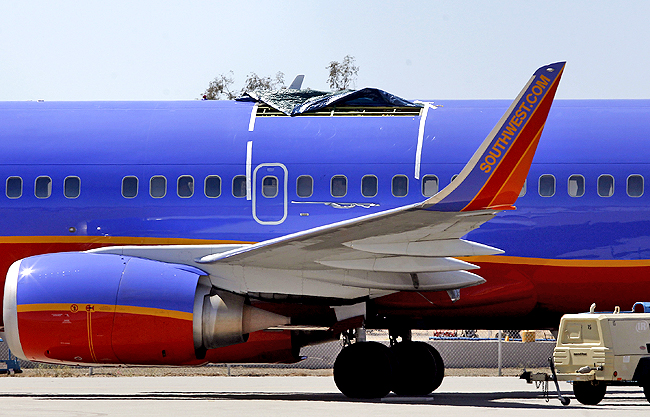By BOB CHRISTIE and JOAN LOWY
Associated Press
PHOENIX - Federal aviation officials readied an order Monday for emergency inspections on 80 U.S.-registered Boeing 737 jetliners like the one on which a piece of fuselage tore away more than 30,000 feet above Arizona last week.
The order, to be issued Tuesday, is aimed at finding weaknesses in the metal in the fuselage, but virtually all of the affected aircraft will have already been inspected by the time the order takes effect.
A 5-foot-long hole opened up in the roof of the Southwest Airlines plane soon after takeoff Friday from Phoenix, causing a loss of pressure and forcing pilots to make an emergency landing 125 miles to the southwest in Yuma, Ariz. No one was seriously hurt.
The safety directive applies to about 175 aircraft worldwide, including 80 planes registered in the U.S., the Federal Aviation Administration said. Of those 80, nearly all are operated by Southwest. Two belong to Alaska Airlines.
After the midair incident, Southwest grounded nearly 80 Boeing 737-300s for inspections. By Monday evening, 64 were cleared to return to the skies, and three were found with cracks similar to those found on the Arizona plane.
Friday's incident, however, raised questions about the impact that frequent takeoffs and landings by short-haul carriers like Southwest put on their aircraft and the adequacy of the inspections.
Since there had been no previous accidents or major incidents involving metal fatigue in that spot of the fuselage, Boeing maintenance procedures called only for a visual inspection by airlines.
But airlines, manufacturers and federal regulators have known since at least 1988 that planes can suffer microscopic fractures. That year, an 18-foot section of the upper cabin of an Aloha Airlines 737-200 separated in flight, sucking out a flight attendant.
The order is "certainly a step in the right direction," said National Transportation Safety Board member Robert Sumwalt, who is in Yuma with the board's accident investigation team.
The FAA's emergency order will require initial inspections using electromagnetic devices on some Boeing 737 aircraft in the -300, -400 and -500 series that have accumulated more than 30,000 takeoffs and landings, the agency said.
It will then require repetitive inspections at regular intervals.
Southwest's jet was 15 years old and had logged 39,000 pressurization cycles, a measurement of the number of takeoffs and landings. That's 7.2 cycles every day for every year it has been in service.
Boeing said Monday that it will issue guidance this week on how airlines should do checks on the affected airplanes now in service. An estimated 1,800 airplanes, including -300, -400, -500 model 737s, are affected by the aircraft maker's service bulletin.
The problem of what is known as "widespread fatigue damage" in aging planes has a long, well-documented history.
It became a major safety focus of the FAA and was the subject of congressional hearings after the Aloha Airlines incident. The NTSB cited such fatigue damage as a contributor to that accident.
Widespread fatigue damage is characterized not only by visible cracks, but also microscopic, subsurface fractures that aren't visible and had been going unnoticed in inspections.
Following the Aloha accident, FAA instituted a new safety regime for older 737s for cracking that includes not only visual inspections, but the use of devices that employ electromagnetic, or high frequency eddy, currents to spot fatigue and corrosion.
---
Lowy reported from Washington. Associated Press writers David Koenig in Dallas; Joshua Freed in Minneapolis and Scott Mayerowitz in New York also contributed to this report.

